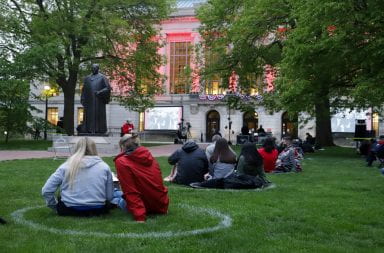Ohio State graduate student Teoma Naccarato exposed her choreography and dance ability Friday during OSU’s Department of Dance show “Exposure” at Sullivant Hall Theater.
“Exposure” presented two dance films along with a live performance of Naccarato’s piece, also titled “Exposure.” Friday was the U.S. debut of the films.
The first film, “Surfacing,” started with a woman dancing on a rock and in a stream. She was then joined by a second woman.
The two danced in the stream and on a hill using large arm movements and partnered motions that became almost animalistic at times.
The second film, “Dances for Small Spaces: Ame” featured Naccarato dancing in an overflowing sink in a confined stall. At times, a male dancer, Lael Stellick, would appear, but this film focused on Naccarato’s ability to move in the confined space.
When the films were over, dancers took the stage to perform Naccarato’s “Exposure.” Naccarato said she used her knowledge of video and lighting to incorporate these elements and intensify her piece.
“Exposure” explored the body’s interaction with technology, disease and other everyday elements, Naccarato said. These themes inspired the title.
Naccarato said her incorporation of different elements into her dancing, such as the lighting and video used in “Exposure,” has come with her evolution as a dancer. She said she it enhances the movement.
Throughout the performance, different effects were projected onto a screen at the back of the stage, including television fuzz and shots of the dancers at different angles.
Some people who knew Naccarato said the show was a good reflection of her as both a dancer and a person.
“It was great. I thought it was all-in-all a really vulnerable evening,” Nordstrom said, “and I mean that in the sense that the choreography was a good look into who Teoma is as a person and a good reflection on her dance style.”
Naccarato said she hopes the performance was thought-provoking for the audience and that they reference it later when exploring different ideas about life.
“I hope it leads to self-reflection for audience members so they come to reference the material later,” she said. “Hopefully, they will proceed to turn it into a dialogue in their own lives.”


